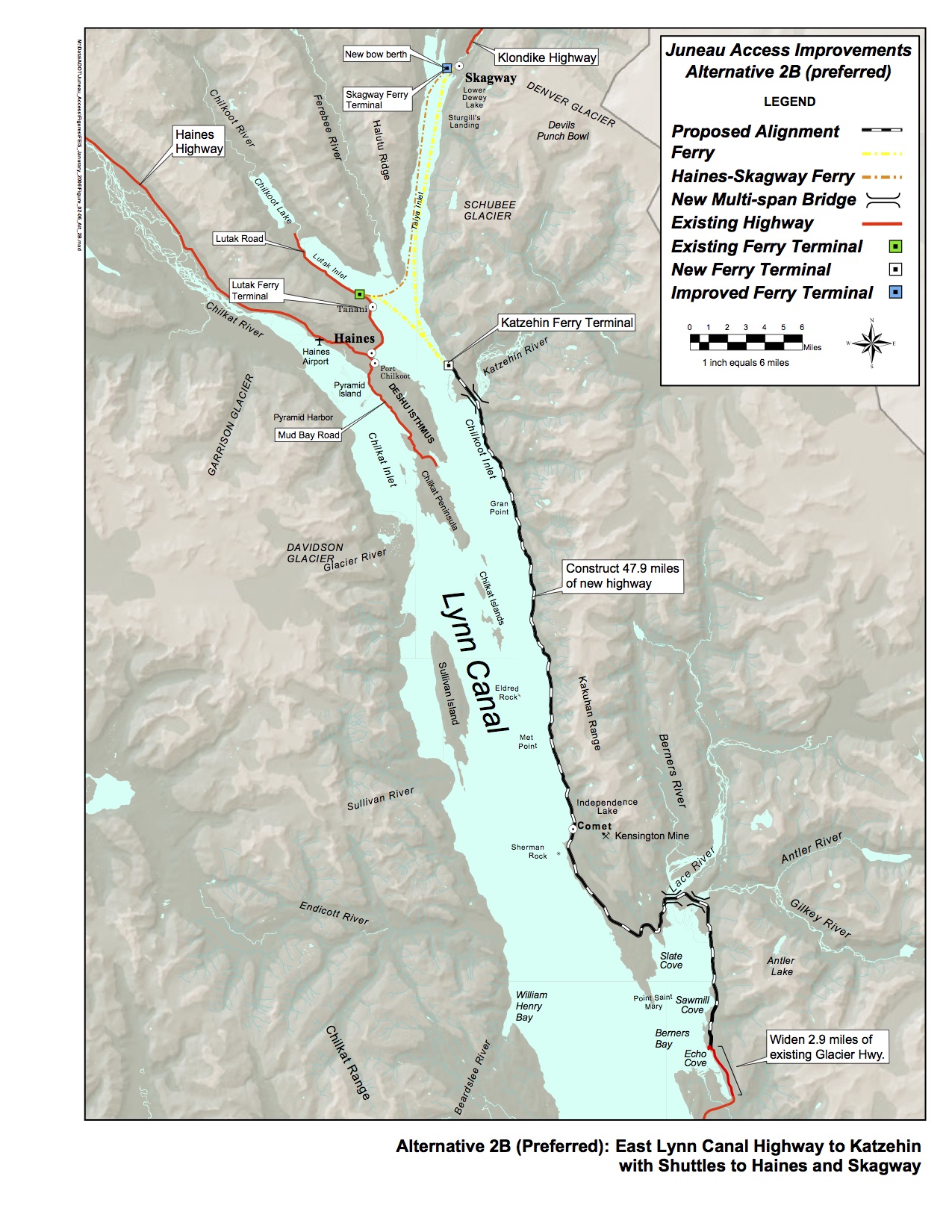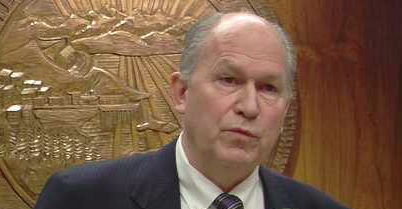 It could have been the William Walker Highway. And it still can be.
It could have been the William Walker Highway. And it still can be.
In early 2015, Alaska Gov. Bill Walker halted the one project that could be built during his time in office: The Juneau Access Project: Preferred Alternative, 2B.
His move to kill Juneau Access was an Alaska-sized mistake by a rookie governor who got snookered by hard-left elitists.
But it’s not too late for him to leave a legacy.
Gov. Walker was never going to get to build a dam at Susitna-Watana. The money is just not there, and the project would have to work its way through the environmental lawsuits, which would have dragged on for years.
He wasn’t going to get a crossing over the Knik Arm — again, it’s 10 years, was not yet a federal priority, and was multi-lawsuits away. His left-leaning political base would never have tolerated it.
But a 50-mile road to Juneau? He can get that built. It’s doable.
The environmental impact statement was nearly done when he took office. The project was about as shovel-ready as a project could get when he simply shut it down.
The $574 million road would be funded primarily by federal dollars. State funds have already been appropriated.
Juneau Access would provide employment for more than 500 Alaskans during its construction. And this is a time when Alaskans sorely need the jobs.
The road to Juneau would wind its way north up Lynn Canal, around Berner’s Bay and end at a new ferry terminal at Katzehin.
From there, a 27-minute shuttle ferry crossing to Haines and a ferry to Skagway would run several times a day, the way ferries do between Port Townsend and the San Juan Islands. The two Alaska-class ferries for the Juneau Access Project are under construction in Ketchikan.
Later, Walker somewhat sheepishly put the project back on the stove because, as he learned, it’s a federally backed highway and he’d have to pay the feds tens of millions of dollars if he stopped the environmental impact study midway.
Thus, the EIS was completed, the preferred alternative was identified, and the project now awaits Walker’s decision.
THE WAIT OF A LIFETIME IS NEARLY OVER
This week it looks like the decision on Juneau Access may be at hand, after what has become two decades of waiting.
Governor Walker’s Legislative Director Darwin Peterson, is calling all three members of Juneau’s legislative delegation to the Third Floor of the Capitol on Wednesday. The meetings will be done separately, we are told. The governor will not be present.
When a governor gives good news, he does it in person, typically. When it’s bad news, he has a functionary do the work. The tea leaves on his decision are hard to read.
The Juneau delegation is split on the road: Rep. Cathy Munoz and Sen. Dennis Egan favor it; Rep. Sam Kito and incoming Rep. Justin Parish oppose it.
Juneau, as a community, is also somewhat split, with a majority favoring it. But this is more than about what Juneau wants. It’s about the state and what is best for the state.
We Alaskans need a road to our capital city, and Juneau needs a road out. The current mode of travel is for the elite only, as it can be afforded only by the well-heeled, not the working class.
The status quo limits access to our elected officials. The lack of a road creates inefficiencies that accentuate the pressure for a capital move.
Ferries, for example, only meet seven percent of the total travel demand for Lynn Canal, and are extremely costly to use. They’re breaking the bank of a State with precious little money to spare.
Right now, if a family of four wants to go from Juneau to Skagway for the weekend, it will cost over $600 round trip.
Yet that only pays for a fraction of the cost: For every $3 a ferry ride costs, the state pays $2 and the rider pays $1. That family going to Skagway is costing the state $1,200 roundtrip. Alaskans also subsidize visitor travel at that same rate.
The drive to Skagway on the road with short shuttle ferry would cost the same family $134 round trip.
Twenty years ago, the annual State subsidy was $28.8 million. Today it’s over $120 million per year. Alaskans are subsidizing the ferry system at nearly 70 percent, more than double the subsidy for the Washington State Ferries.
What else is at stake? Freight would be cheaper if Juneau had better access. Tourism access would be improved, and independent travelers would become a significant source of tax revenue for the capital city, as well as for Haines and Skagway, both already connected to the rest of the road system. Shipping fresh seafood would be far cheaper.
The Walker Administration has been lobbied by both sides — pro-road types on the one hand and the anti-road, eco-elitists on the other.
But within his Administration, it’s an anti-road club that wants to keep people out of Juneau. They’re likely to swing the decision.
The pro-road people in Juneau are nervous this week. And rightly so: This administration has yet to come down on the side of generating economic activity anywhere in the state.
WHERE IS UNION SUPPORT FOR ROAD CONSTRUCTION JOBS?
The unions back the Juneau Access Project. This highway would bring construction jobs by the hundreds. It’s a project of bonanza proportions.
During a time when Alaska jobs are at their lowest level since the catastrophic crash of the 1980s, and there are precious few construction jobs left in the economic pipeline, union representatives are one of the few influential classes that has the governor’s ear.
It’s been two years of quiet diplomacy for union leaders. They helped get Walker where he is today, and now they are wondering if he’s forgotten their support. They’ve talked to Walker numerous times, but is he listening? They don’t know.
Union representatives like Corey Baxter, Joey Merrick, Tom Brice, and Don Etheridge have met with the governor in his office and at the Governor’s Mansion on this very topic. They catch his ear wherever they can, whether at the ice rink or a local store.
Ken Koelsch, Juneau’s mayor since March, has done his part to convince Walker to approve the preferred alternative identified by the road study.
WILL THE GOVERNOR TRY ALTERNATIVE 4D?
Some say the governor may choose a different alternative — the one known as 4B, which would be known as the “Walker Culdesac.”
This five-mile version would be a way for him to use up some of the federal money, and it would extend the road as far as Berner’s Bay. But it would cost almost $1 billion. It’s the ridiculous alternative of splitting the baby in two.
This is not how Walker wants to be remembered in a year when we’re commerating the 75th anniversary of the Alcan Highway: Building the equivalent of a back alley.
If that is his choice, he should just shelve the entire project right now: It’s a nonstarter that has none of the benefits of the preferred alternative and will cost more money to maintain in the long run. It’s an insult to Alaskans.
The decision Gov. Walker announces this week will tell the working people of Alaska everything they need to know about whether he is supportable as governor in 2018.
The business community, working Alaskans, and union leaders are united on this one. Will Walker go with them or with the disconnected no-road elitists?
It’s not too late for Gov. Walker to be the governor who, as he says, “likes to build things” — and then actually builds them.

Yes, it may create a bunch of short term jobs, but how much is it going to cost the state to maintain annually, realistically?
Not even close to the subsidy of $120,000,000 a year it dishes out for the AMHS…really??? Is that a pragmatic question???
Building a road will not do away with the ferries, so that $$ can’t simply be considered money in the bank.